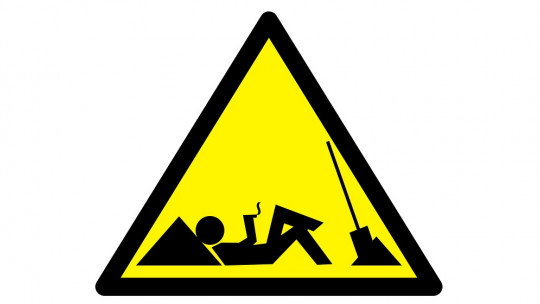In the work environment, productivity has become the cornerstone for success, professional progress, and even social and personal worth. This can lead to psychological problems related to stress or social comparison when we feel a lot of pressure related to productivity. Among them, productivity paranoia appears the form of distrust that managers or superiors feel towards their workers and their productivity.
As companies and businesses strive to remain competitive and within the commercial wheel in a market as globalized and demanding as the current one, employees are under constant pressure to be more productive and achieve increasingly higher goals. Labor managers, often influenced by the fear of failure, can develop paranoid attitudes of distrust in the abilities and performance of their employees.
Throughout this article, we will explore in detail the phenomenon of productivity paranoia and its implications in the work environment, considering its influence on both employers and workers. We will also look at strategies to achieve a healthier work environment, based on mutual trust and establishing realistic expectations.
What is productivity paranoia?
Productivity paranoia is the persistent belief or attitude of distrust on the part of managers or labor superiors towards their workers, regarding their ability to meet the expected productivity levels This paranoia manifests itself in constant surveillance and suspicion about the performance of employees, generating a work environment full of mistrust and pressure.
Key characteristics of productivity paranoia include an excessive obsession with performance and efficiency, as well as a constant worry about failing to meet set goals. Labor managers who suffer from productivity paranoia tend to have a mentality of “if I don’t control it, I can’t trust it to be done right.” As a result, they may adopt a micromanagement approach, closely monitoring and supervising their subordinates’ every task and becoming obsessed with it, without maintaining effective two-way communication.
This constant distrust in employee performance can lead to the imposition of unrealistic deadlines and goals, as well as excessive workload. Productivity paranoia creates a tense and stressful work environment, where employees may feel constantly evaluated and under pressure to prove themselves and avoid criticism or retaliation.
It is important to keep in mind that productivity paranoia not only affects the relationship between job managers and employees, but also can have a negative impact on workers’ motivation, mental health and general well-being , which in turn generates impediments to achieving the expected productivity. Properly addressing and managing this paranoia is essential to cultivating a healthy work environment, based on mutual trust and supporting employee growth and development.
Causes of productivity paranoia
Next, we are going to explore some possible causes why productivity paranoia appears and persists over time:
1. Work pressures and competitiveness
In a highly competitive business and economic environment, organizations seek to maximize their efficiency and obtain optimal results that position them at the top compared to other companies or businesses in the sector. This can generate significant pressures on those responsible for labor, who feel the need to ensure their teams meet established productivity standards Constant competition can contribute to productivity paranoia, as job managers fear falling behind or not achieving desired goals.
2. Organizational culture and excessive expectations
In some organizations, a culture is fostered that exclusively values productivity and performance at the expense of employee well-being This can lead to the creation of a work environment where job managers maintain high expectations and are constantly monitoring the performance of their subordinates. The fear of not meeting these expectations can generate a feeling of paranoia in both employees and job managers.
3. Previous experiences and fear of failure
Job managers may develop productivity paranoia as a result of previous experiences in which they have faced situations of poor performance or failure. These experiences can lead them to distrust their subordinates, believing that similar situations could happen again in the future. Fear of failure can intensify the need to constantly monitor and supervise employees’ work.
4. COVID-19 pandemic
Although this cannot be defined as a direct generator of employers’ distrust in the productivity of their employees, many studies point to the intensification of the emergence of productivity paranoia as a result of the pandemic and the increase in remote work. . This complicated the visibility of what the workers were doing, and there began to be distrust about the actual achievement of the objectives. In addition, it is worth considering the economic situation that affected the entire planet as a result of this global stoppage, which may increase competitiveness or lack of sufficient performance in their companies by superiors.
Negative effects of productivity paranoia
This paranoia can manifest itself in various ways in the work environment. Labor managers can become excessively demanding, setting unrealistic deadlines or imposing overwhelming workloads on their subordinates. They may also be constantly monitoring and evaluating employee performance, creating an environment of pressure and stress These manifestations can have negative effects on employee motivation, mental health, and job satisfaction.
1. Stress and exhaustion
The constant surveillance and pressure exerted on employees can generate high levels of stress in them. The feeling of always being under scrutiny and the constant worry about meeting productivity standards can lead to physical and emotional exhaustion. Chronic stress associated with productivity paranoia may contribute to health problems such as sleep disorders, anxiety and depression.
2. Decreased motivation and creativity
Productivity paranoia can lead to a decrease in employee motivation and creativity. When they feel constantly controlled and supervised, employees may experience a lack of autonomy and a feeling that their work is not valued beyond quantifiable results. This can limit your ability to innovate, take risks, and find creative solutions to work challenges.
3. Lack of collaboration and deterioration of the work environment
Constant mistrust and surveillance can damage interpersonal relationships and collaboration within the work environment. Employees may become more reserved and reluctant to share ideas or collaborate with colleagues due to fear of being judged or criticized This is an undoubted cause of the deterioration of the work environment, generating constant tension that in turn intensifies all the other negative effects of productivity paranoia.
4. Reduced quality of work
Productivity paranoia can lead to an obsession with meeting deadlines and goals, at the expense of quality work. Employees may feel pressured to finish tasks quickly, which can lead to errors and lack of attention to detail. Lack of focus on excellence and quality of work can affect company reputation and customer satisfaction.
Strategies to counteract it
As a conclusion to this article, we offer some ways or tools to manage this productivity paranoia and counteract its negative effects, managing to improve both the morale and motivation of workers and the direction and results of the company or business.
1. Encourage open communication
Establishing clear and open communication between managers and employees can help build trust and reduce productivity paranoia. This implies provide constructive feedback on a regular basis and address any concerns or misunderstandings in an open and respectful manner.
2. Set realistic goals
It is important to set achievable and realistic goals and objectives to avoid generating excessive pressure and distrust in employees. It is important to ensure that goals are clear, measurable and aligned with available capabilities and resources.
3. Foster a supportive and collaborative environment
Promoting a work environment that values collaboration, mutual support, and teamwork can counteract productivity paranoia. Encouraging participation in joint projects, encouraging employees to share knowledge and skills, and creating opportunities to celebrate collective achievements are some examples of increasing and promoting this group sense of community.
4. Promote work-life balance
It is vital to recognize the importance of work-life balance for employees. To achieve this, practices such as work flexibility, reasonable hours and the promotion of comprehensive well-being can be supported. By allowing employees time to rest, recover, and engage in activities outside of work, a healthier environment is fostered and the feeling of being constantly under pressure is reduced
5. Encourage professional development and training
Providing development and training opportunities to employees demonstrates a commitment to their personal growth and success. This helps build confidence and motivation as employees feel supported in their professional development. Providing tools and resources to improve skills and knowledge can also increase confidence in employees’ ability to meet job expectations.









